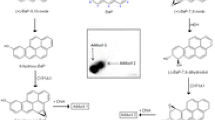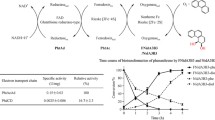Abstract
THE enigma of how inert chemicals can exert potent mutagenic, carcinogenic, allergenic and cytotoxic effects has been much debated. It has been learned that such compounds are metabolically converted to chemically reactive species1. In the case of aromatic or olefinic compounds, monooxygenases located in the membranes of the cell can transform these compounds into epoxides2–5 which by virtue of electrophilic reactivity can bind chemically to cellular macromolecules such as DNA, RNA and proteins, thereby disturbing biochemical control mechanisms and leading to the above mentioned toxic effects. The same membranes in which such epoxides are produced possess an enzyme, epoxide hydratase, which is capable of inactivating epoxides2–4. However, with polycyclic hydrocarbons the situation is more complicated. If the epoxide groups are located on a benzo ring opposite a bay region, the resulting dihydrodiols are precursors of even more reactive dihydrodiol epoxides which readily bind to DNA6, are often strongly mutagenic7–10 and may be mainly responsible for carcinogenic effects of some polycyclic hydrocarbons11. Because, with the environmental carcinogen benzo(a)pyrene, epoxide hydratase was unable to inactivate these dihydrodiol epoxides12,13, we have investigated the ability of a dihydrodiol dehydrogenase14–16 to sequester the precursor dihydrodiols and thereby afford protection. To this end we have used bacterial mutagenesis17 as the biological endpoint to investigate the metabolic activation of benzo(a)pyrene by microsomal monooxygenase. Unfortunately, the dihydrodiol dehydrogenase requires the same pyridine nucleotide cofactor as the monooxygenases, so that simple removal or addition of cofactors could not be used to study the role of this enzyme. Therefore purification of the enzyme was necessary. We show here that in metabolic situations where epoxide hydratase cannot protect against benzo(a)pyrene metabolite-evoked mutagenicity, pure dihydrodiol dehydrogenase reduces it. This demonstrates another factor which could contribute to differences in susceptibility to polycyclic hydrocarbon-mediated toxicity between various animal species, strains, sexes, organs and developmental stages, and to differences in potency of polycyclic compounds. This enzyme also provides an additional tool for studying the molecular mechanisms of chemical carcinogenesis.
Similar content being viewed by others
References
Miller, J. A. & Miller, E. C. in Chemical Carcinogenesis (eds Ts'o, P. O. P. & DiPaolo, J. A.) part A, 61–85 (Marcel Dekker, New York, 1974).
Daly, J. W., Jerina, D. M. & Witkop, B. Experientia 28, 1129–1149 (1972).
Oesch, F. Xenobiotica 3, 305–340 (1973).
Sims, P. & Grover, P. L. Adv. Cancer Res. 20, 165–274 (1974).
Heidelberger, C. A. Rev. Biochem. 44, 79–121 (1975).
Sims, P., Grover, P. L., Swaisland, A., Pal, K. & Hewer, A. Nature 252, 326–327 (1974).
Malaveille, C., Bartsch, H., Grover, P. L. & Sims, P. Biochem. biophys. Res. Commun. 66, 693–700 (1975).
Huberman, E., Sachs, L., Yang, S. K. & Gelboin, H. V. Proc. natn. Acad. Sci. U.S.A. 73, 607–611 (1976).
Newbold, R. F. & Brookes, P. Nature 261, 52–54 (1976).
Wislocki, P. G. et al. Biochem. biophys. Res. Commun. 68, 1006–1012 (1976).
Kapitulnik, J. et al. Cancer Res. 38, 354–358 (1978).
Bentley, P., Oesch, F. & Glatt, H. R. Archs Tox. 39, 65–75 (1977).
Wood, A. W. et al. in In vitro Metabolic Activation in Mutagenesis Testing (eds de Serres, F. J., Fouts, J. R., Bend, J. R. & Philpot, R. M.) 179–195 (Elsevier, Amsterdam, 1976).
Ayengar, P. K., Hayaishi, O., Nakajima, M. & Tomida, I. Biochim. biophys. Acta 33, 111–119 (1959).
Jerina, D. M., Ziffer, H. & Daly, J. W. J. Am. chem. Soc. 92, 1056–1061 (1970).
Booth, J. & Sims, P. Biochem. Pharmac. 25, 979–980 (1976).
Ames, B. N., McCann, J. & Yamasaki, E. Mutat. Res. 31, 347–364 (1975).
Oesch, F. & Glatt, H. R. in Screening Tests in Chemical Carcinogenesis (eds Montesano, R., Bartsch, H. & Tomatis, L.) 255–274 (IARC, Lyon, 1976).
Oesch, F., Thoenen, H. & Fahrländer, H. J. Biochem. Pharmac. 23, 1307–1317 (1974).
Walker, C. H., Bentley, P. & Oesch, F. Biochem. biophys. Acta 539, 427–434 (1978).
Burk, M. D. & Mayer, R. T. Drug Metabolism Disposition 2, 583–588 (1974).
Oesch, F. J. biol. Chem. 251, 79–87 (1976).
Oesch, F., Bentley, P. & Glatt, H. R. Int. J. Cancer 18, 448–452 (1976).
Wislocki, P. G. et al. Cancer Res. 36, 3350–3357 (1976).
Glatt, H. R. & Oesch, F. Mutat. Res. 36, 379–384 (1976).
Oesch, F., Kaubisch, N., Jerina, D. M. & Daly, J. W. Biochemistry 10, 4858–4866 (1971).
Author information
Authors and Affiliations
Rights and permissions
About this article
Cite this article
GLATT, H., VOGEL, K., BENTLEY, P. et al. Reduction of benzo(a)pyrene mutagenicity by dihydrodiol dehydrogenase. Nature 277, 319–320 (1979). https://doi.org/10.1038/277319a0
Received:
Accepted:
Issue Date:
DOI: https://doi.org/10.1038/277319a0
- Springer Nature Limited
This article is cited by
-
The past and the future of toxicology
Archives of Toxicology (2008)
-
Significance of various enzymes in the control of reactive metabolites
Archives of Toxicology (1987)





